The ASUS ROG Strix G15 (G513QY) Review: Embracing AMD's Advantage
by Brett Howse on May 31, 2021 11:00 PM ESTGPU Performance
The heart of any gaming laptop is the GPU, and with the AMD Radeon RX 6800M, the ASUS Strix G513QY offers one of the fastest GPUs in a notebook computer. AMD’s latest RDNA2 graphics architecture is at the core of the platform, which also offers new synergies when paired with the AMD Ryzen 5000 processor.
The AMD Radeon RX 6800M sits at the top of their product stack, and AMD feels it can go toe to toe with NVIDIA’s RTX 3080L. Designed for systems with 145-Watt TDPs and above, the 6800M can push a laptop to its limits. Thanks to AMD SmartShift, which leverages machine learning algorithms to match the workload with the power requirements, the 6800M can be boosted up to 15% by shifting some of the processor power budget over to the GPU.
Thanks to the RDNA2 architecture, the Radeon RX 6800M also gets new features such as hardware ray acceleration, and variable rate shading. The former will improve visuals on games that support it, while the latter will improve performance by reducing the shading effort on portions of the image where it is not important, while keeping the full visual fidelity where the player will notice it. As both features require developer support, this won’t impact all games, but partially thanks to AMD’s win in the console space, features like variable rate shading already are available in some titles.
The Radeon RX 6800M features 40 compute units, with a 2300 MHz frequency. It also is able to be switched off when not in use, which is very important for a notebook, and AMD claims a near 0-Watt power level when in the disabled state. There is also 96 MB of Infinity Cache, which is a global cache for fast data access at lower power levels. In addition, AMD offers Smart Access Memory, which requires a Ryzen 3000 or Ryzen 5000 processor, and allows the CPU to bypass the typical 256 MB limit per transaction.
Although similarly named to the desktop counterpart, the Radeon RX 6800, AMD, like NVIDIA, has to deal with far more constrained thermals in the notebook form factor, which limits TDP much more than the desktop cards, which can draw 300+ Watts on their own. AMD focuses the 6800M on the 145-Watt and over range, and targets the GPU at 2560x1440 resolution panels. The review unit AMD sent is just a 1920x1080 panel though, albeit a 300 Hz refresh rate FreeSync IPS LCD. A device such as this would target the lowest latency for e-sports and the like, since the Radeon RX 6800M is really too much GPU for this resolution as we will see shortly.
As usual, we’ll kick off with some synthetics, then move on to some gaming tests.
3DMark
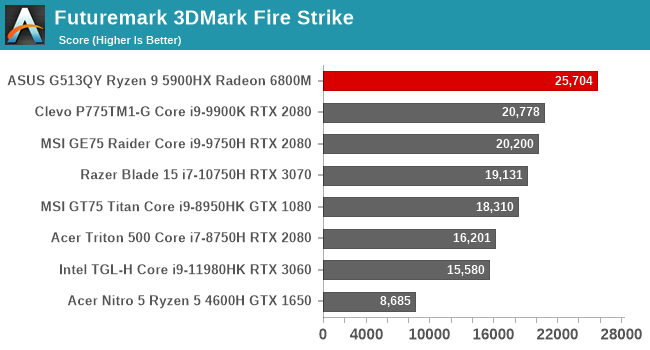
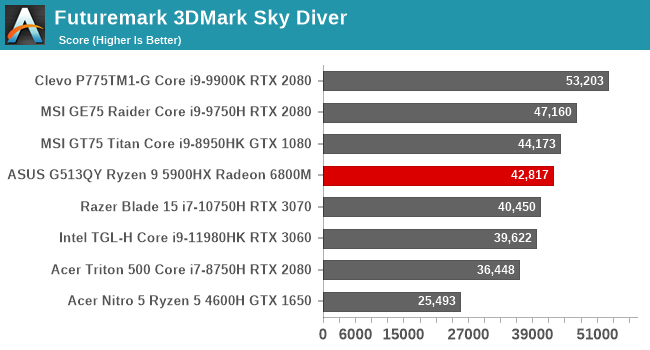
UL’s 3DMark offers several workloads with varying levels of complexity. Generally, as the workload gets less complex, it becomes more CPU bound. The ASUS Strix G513QY demolishes the competition in the most complex test of this suite, Fire Strike, but then falls back as the workloads get lighter and the CPU comes more into play.
GFXBench
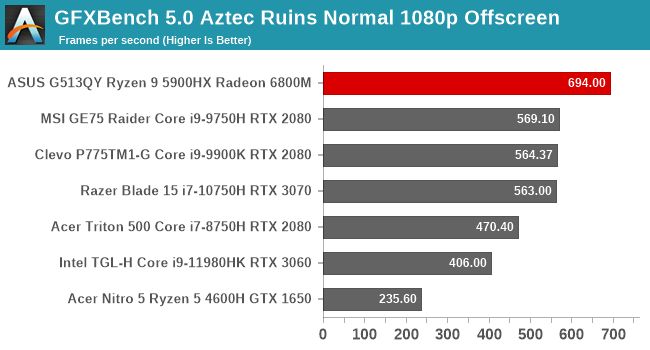
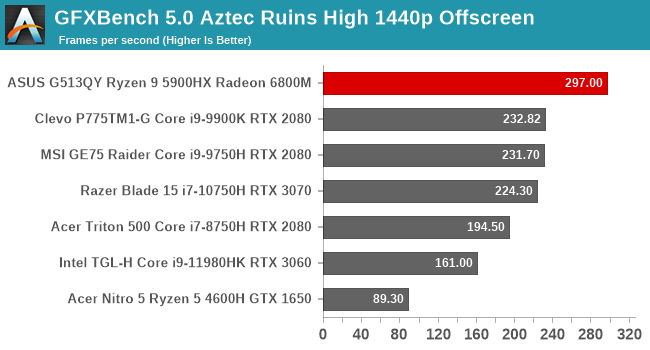
With version 5.0 of GFXBench, Kishonti added DirectX 12 workloads to their suite, which are the two we run. GFXBench is geared towards lower-powered devices, including tablets, so running them on a GPU such as this is more academic than useful, but as it is part of our normal suite, it was run here as well, and unsurprisingly the Radeon RX 6800M had no issues with such a small amount of work.
Tomb Raider
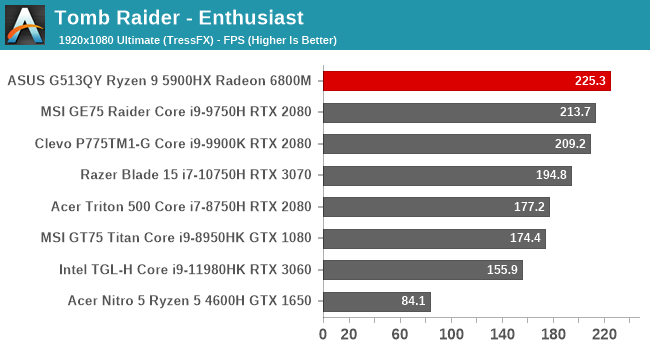
Although an older game, we keep Tomb Raider around mostly for the integrated graphics solutions, so it should be no surprise that the ASUS G513QY crushes this benchmark. Enjoy the 300 Hz display, because it will get a workout here.
Rise of the Tomb Raider

The second installment in the Tomb Raider franchise increased the visuals significantly, which results in a much more stressful test, but here the Radeon RX 6800M does not really do overly great in the DirectX 12 mode. Likely at this resolution, the benchmark is 100% CPU bound.
Shadow of the Tomb Raider
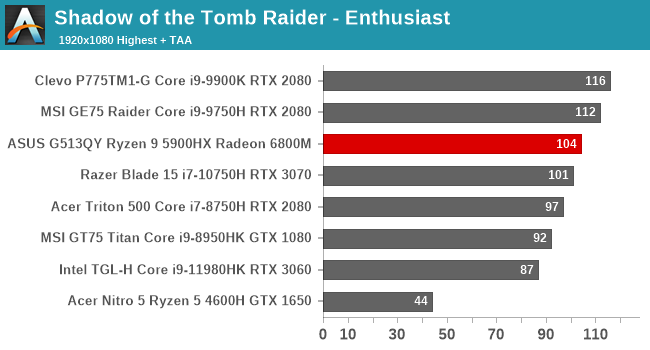
One of the best aspects of the Shadow of the Tomb Raider benchmark is that it outputs the percentage of how often the framerate was GPU bound. It very much confirmed the previous data points here, since at the 1920x1080 resolution with everything set to its highest level in terms of fidelity, the benchmark was GPU bound 0% of the time. Translating that, it means that in fact, the 6800M is 100% CPU bound on these tests.
Strange Brigade
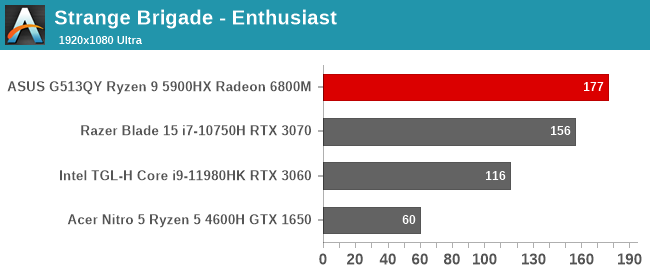
One of the newer titles to our suite is Strange Brigade, and the DirectX 12 title offers a wide range of performance levels, allowing it to be played on anything from integrated graphics, all the way up to top-tier GPUs. Although likely CPU bound again, the 6800M is still very fast.
Shadow of War
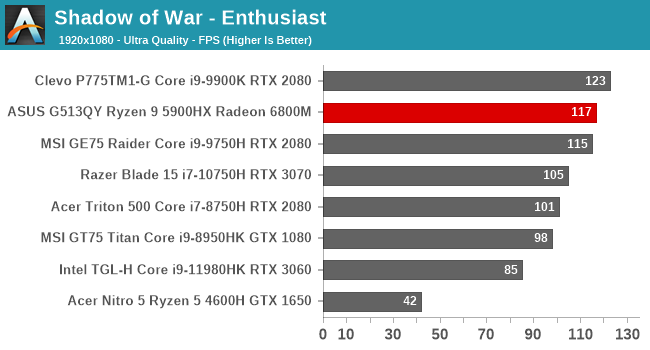
In a theme that seems to keep repeating itself, the ASUS Strix G513QY continues to not really set itself apart from the competition at this resolution. It still does well but is clearly being held back.
Far Cry 5
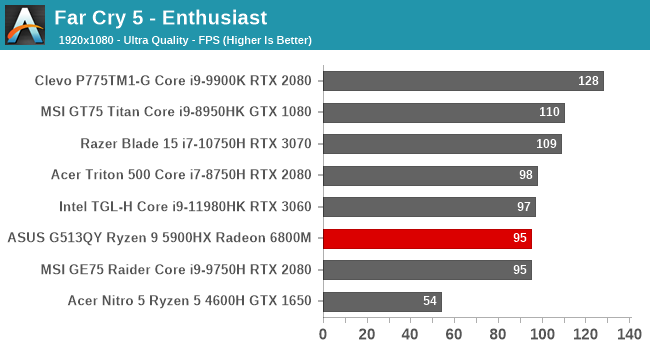
In what may be the most CPU-bound game in the suite, it is probably no surprise to see the ASUS where it is.
UHD Benchmarks
Although the ASUS G513QY is offered with a 2560x1440 panel, and almost certainly that would be the correct one to go with for this system, AMD sent us the 1920x1080 panel for the review, and that is a shame. There is a lot of performance left on the table. To see just how capable the GPU is, it was plugged into an external UHD monitor and some of the workloads were re-run.

Remember Shadow of the Tomb Raider saying it was GPU bound 0% of the time at 1920x1080? At UHD it was 77% of the time GPU bound. That is more like it. At the highest settings, most of these games can hit 60 FPS average even at 3840x2160, and a game like Shadow of the Tomb Raider would just need some tweaks to the settings to achieve that as well. The Radeon RX 6800M is really one of the first laptop GPUs that could power a UHD panel, and yet the unit it ships in is a 1920x1080 resolution, offering just one quarter of the pixels.
GPU Conclusion
AMD targets the Radeon RX 6800M at 2560x1440, and for good reason. As we have seen, in pretty much every title, it is completely CPU bound at 1920x1080, even with the newest Ryzen 9 5900HX as the processor. The synthetic tests, as well as the UHD resolution results, really prove this point.
Although there is certainly a market where the 1920x1080 resolution is desired for the lowest latency, in this system, that panel is really too low of a resolution for such a powerful GPU, and it becomes wasted money spent.


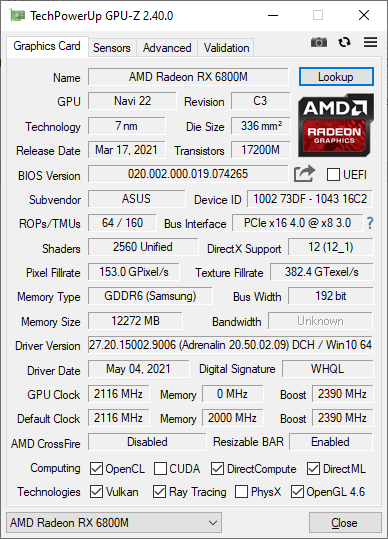








146 Comments
View All Comments
Makste - Tuesday, June 1, 2021 - link
Breath taking implementation. Swap the screen, I'll deal with the lack of webcam, I want this laptop.TOV - Tuesday, June 1, 2021 - link
Have you changed the RAM and test it again? Jarrod's tech test result +20% after he changed them.Techie2 - Wednesday, June 2, 2021 - link
If not for all the bribe money that Intel spends to prevent companies from building high end AMD laptops, AMD would own the laptop market based on performance. Asus has always taken the bribe money so don't expect them to embrace AMD significantly be it in laptops or desktop mobos.ToTTenTranz - Wednesday, June 2, 2021 - link
Why is the supposed GPU test page comprised of a bunch of CPU limited scenarios?ExarKun333 - Wednesday, June 2, 2021 - link
Why is this being compared to such old laptops? Why no 3080s with different TDPs and 10/11 gen Intel + ryzen 3000?IBM760XL - Wednesday, June 2, 2021 - link
Shut up and take my flatmate's money! He's got an MSI Raider with a 2080 (probably the same model in the comparison charts), and the whole flat agrees it's obnoxiously loud, even at idle. I'm going to show him this review tomorrow and tell him to sell the MSI and buy this as soon as it's available. Saying this as someone who has a (much quieter, somewhat thicker) MSI myself.Aside from the fact that my ears really want one of these in the house, it looks pretty nice in general. The fingerprint magnets are unfortunate, but otherwise it would very likely be in the running if I were in the market for a new laptop... or even just a powerful GPU in general. I'm excited to see AMD offer such a complete package, and at a reasonable price. The battery life for a gaming laptop is especially impressive. Gotta iron out those WiFi goblins though, I'd probably use it on Ethernet 85-90% of the time, but few things are more aggrieving in a computer than spotty WiFi.
boidsonly - Wednesday, June 2, 2021 - link
I've been wanting an all AMD laptop for a while now but never felt they were ready for prime time until now. If I can find this at MSRP I will buy it.FakThisShttyGame - Wednesday, June 2, 2021 - link
I wish they remove the screen and keyboard and keep this thin for my next gaming desktopDoofusOfDeath - Thursday, June 3, 2021 - link
Anyone know if the 2560x1440 panel will be brighter? I'm looking for a laptop that's usable in a semi-outside setting, and max 300 nits isn't ideal.Brett Howse - Friday, June 4, 2021 - link
The QHD is rated at the same 300 nits.